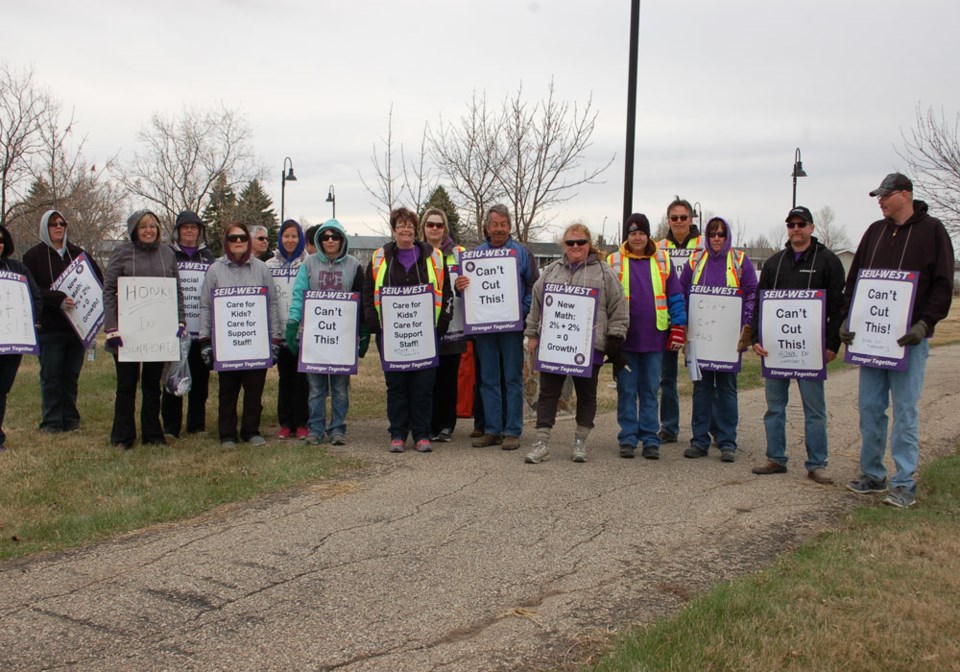The strike orchestrated by the Service Employees International Union against the South East Cornerstone Public School Division is now entering its second week.
Barbara Cape, president of SEIU-West said morale remains high among the strikers who have taken to the picket lines to publicly state their case.
In the meantime, the school division continues to operate as normally as possible under the circumstances without the input of the 261 employees who are education assistants, bus drivers, cafeteria/kitchen workers, library technicians or administrative assistants among other jobs.
Both sides of the dispute are declaring they are open to an invitation to return to the bargaining table, but as of April 27, neither one had blinked.
“The ball is in their court,” said Cape. She added that “right before the walk-out last Wednesday we contacted the board and they said there was nothing new to offer and no reason to meet.”
Both Cape and Cornerstone director of education Lynn Little, believe there can be some common ground to be found.
If that doesn’t happen soon, the union leader said she will continue to visit and monitor the picketers and measure the morale levels, which are pretty high right now.
“We held a barbecue fundraiser for the food bank last Friday in Estevan and raised nearly $1,000. It was a great way to remain visible to the public along with the picket lines and a strong showing of public support. Nobody really wants to be there, but they’re staying strong,” she said.
The last offer made to the union was a four per cent increase in wages over a two-year period, an offer that was similar to one signed by other support workers in the division who are represented by the Canadian Union of Public Employees (CUPE).
That fact is one of the major stumbling blocks that is causing Cornerstone to hesitate on offering anything extra, since it would set the stage for a series of leapfrogging negotiations the next time CUPE arrived at the bargaining table.
Both sides had agreed on the deployment of a provincially assigned conciliator Jim Jeffries, but he was unable to move the two sides closer to an agreement after a series of meetings.
“He’s no longer involved. He didn’t find common ground and didn’t produce a report to the ministry. I believe he sent the Education Minister a letter saying he was unable to find this middle ground,” said Cape.
Little said she wasn’t sure how long the schools affected by the strike would be able to carry on without caretakers, maintenance staff, educational assistants and bus drivers.
“Those people who staff these positions are valuable. We’re trying to mitigate and fill in, but eventually safety or health issues might come up,” said Little.
“We’re hearing from families who are not pleased with the board of education and how they’re handling this,” said Cape. “Students and teaching staffs are being affected. Libraries are closed and we hear kids are cleaning classrooms. I don’t think that’s their role in the education system, they’re supposed to be learning,” said Cape.
Both leaders used the word flexibility in their appeal to, hopefully, return to the negotiating table.
“The door is open for conversation if the opportunity arrives,” said Little. “There is a process in place.”
In the meantime, Cornerstone has developed a plan to reimburse families who have to transport students significant distances to school during the strike.
“We’re seeking equity across the board, in-scope and out-of-scope,” said Little. “We have had a positive relationship and we certainly respect them and the work they do, so I just hope this relationship pulls us together, eventually. Because I know they want what’s best for the kids, just as we do. This commonality will hopefully bring us together, but when and how this will look, I really don’t know at this stage.”
Little said there was no doubt the strike was being watched by a lot of people around the province, all anxious for an outcome.
“So far, we haven’t served any notice to any other school division,” said Cape. “We don’t want to strike, our members didn’t want to leave the people they have bonded with. There is a great strength of character among these employees.”
She added she felt good about the fact that both sides were attempting to reach out, even though it hasn’t yet led to a return to negotiations.
“It’s too early in the process to talk about generating anything more with regards to picket lines. We have set them up for 8 a.m. to 4 p.m. shifts and I’m in continual contact with the captains. Some of the strikers are out doing community work when they’re not picketing,” Cape said.
Little agreed that politicians as well as the general public are monitoring this strike action carefully, since it’s the government that now sets the funding formula and pace for all school divisions in the province and, therefore, have a stake in the outcome.
“There is respect being shown on both sides. I hope that remains and this, too, shall pass,” said Little.
In the meantime, SEIU strikers said they would remain firm in their belief that a four per cent wage hike over two years is well below the cost of living standards, especially in the high inflation sector of southeast Saskatchewan.




